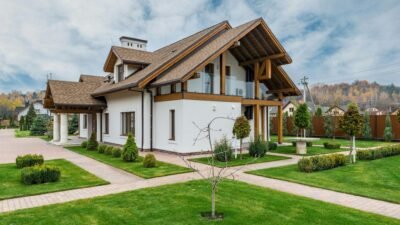A home isn’t simply a structure with walls and a roof – it’s a foundation for comfort, safety, and lasting value. The choices made during construction determine how well a home holds up through the years. Durable materials, smart planning, and attention to critical systems all contribute to a house that doesn’t just look good at first, but continues to perform well for decades.
In this article, we’ll look at the essential steps homeowners, builders, and designers can take to ensure a new home remains solid, efficient, and reliable long after the keys are handed over.
Start with a Solid Foundation
The strength of a home begins with the ground it rests on. Before construction starts, soil testing is vital to understand how stable the land is and what type of support the house will require. A foundation that suits the climate and conditions of the site provides security against shifting soil, water intrusion, and structural problems. Whether it is a slab, crawl space, or full basement, investing in the right foundation keeps the home steady through storms, heat, and time. Builders who cut corners here often create problems that show up years later, and repairs can become far more expensive than doing it right from the beginning.
Plan HVAC Installation from the Start
An HVAC system works best when it is integrated into the overall design of the home. Proper placement of ductwork, vents, and units prevents issues like uneven heating or cooling and avoids costly modifications later. When HVAC installation happens too late in the process, builders may need to adjust walls, ceilings, or insulation, which adds time and expense.
This is why it pays to work with a company that specializes in new construction HVAC solutions. These professionals understand how to design systems that match the home’s layout and insulation plan. Their expertise helps prevent energy loss, keeps utility bills lower, and ensures consistent indoor comfort. A carefully installed system also promotes healthier air quality by reducing dust and humidity problems.
Choose High-Quality Materials for Longevity
The materials used in construction define how well a home will age. While budget constraints can make cheaper options appealing, homeowners often find themselves replacing roofing, siding, or flooring sooner than expected. High-quality materials may cost more upfront, but they last longer and require less maintenance. For example, durable roofing materials resist wind and rain damage, while strong siding protects against mold and insects. Every dollar spent on reliable materials is an investment in fewer repairs and a longer life for the home.
Prioritize Energy Efficiency
Energy efficiency plays a huge role in how affordable and comfortable a home will be in the long run. Insulation, windows, and doors all work together to maintain stable indoor temperatures. Without proper planning, homes can lose heat in the winter and gain too much warmth in the summer, driving up energy bills. Investing in energy-efficient appliances and lighting adds another layer of savings. The benefits go beyond lower costs. Energy-efficient homes also reduce strain on the environment and often have higher resale values. Planning with efficiency in mind from the start ensures that the home will remain comfortable and cost-effective no matter how energy prices change over time.
Focus on Structural Integrity
A house must stand strong against time and weather, and this depends on the skill and precision of the work. Framing, roofing, and load-bearing walls require careful planning and expert execution. Even when using top-quality materials, poor craftsmanship can create weak points that compromise the entire structure. Structural integrity is not something that can be fixed easily later. When built right, the framework of the home provides peace of mind and creates a safe environment for the people living inside it.
Invest in Smart Plumbing and Electrical Systems
Behind the walls of a home lies the network that keeps everything running smoothly. Plumbing and electrical systems may not be visible, but they determine comfort and safety every day. Planning these systems carefully during construction avoids many problems later. Smart plumbing design reduces the chance of leaks, ensures proper water pressure, and keeps maintenance costs down. Choosing high-quality pipes and fittings also extends the life of the system.
Electrical planning is equally important. Outlets should be placed where they will actually be needed, rather than added as an afterthought. Modern homes also require panels that can support advanced appliances, entertainment systems, and even future additions like solar panels or electric vehicle chargers. Investing in these systems from the start provides flexibility, safety, and efficiency for decades.
Design for Comfort and Practical Living
A well-built home should also be practical for the people who live in it. This means thinking beyond the walls and focusing on everyday use. A good layout makes it easy to move from one space to another without awkward hallways or wasted corners. Bedrooms should feel private, kitchens should be functional, and living spaces should welcome natural light. Ventilation also matters, as airflow impacts both comfort and health.
Storage should also be incorporated into the design. Homes without enough closet or cabinet space quickly feel cluttered. Comfort is not only about luxury features—it is about making sure the design fits real life and works smoothly every day.
Weatherproofing and Protection from the Elements
No matter how well a home is built, weather will always test it. Rain, wind, heat, and cold find their way into weak spots if they are not addressed early. Proper weatherproofing protects the structure and keeps the interior safe from damage. This starts with sealing gaps around windows and doors, adding quality insulation, and using materials that resist moisture.
A strong roof is a must, but it must be paired with gutters and drainage systems that guide water away from the home. Without these, even the best roof will not prevent damage. Exterior finishes such as protective coatings or weather-resistant siding provide another layer of security.
When a home is built to stand the test of time, it does more than protect against weather or wear. It becomes a place where families can grow, where memories can take root, and where generations can feel secure. Every choice made during construction contributes to that sense of permanence. Building a home is about shaping a future, not just completing a project. The effort invested today creates a foundation for tomorrow, ensuring the home is more than a structure—it is a legacy.



